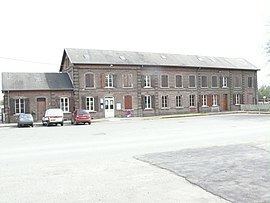Area 6.01 km² | Population (2014) 643 | |
 | ||
Intercommunality Communauté de communes de la Picardie Verte | ||
Abancourt is a French commune in the Oise department in the Hauts-de-France region of northern France.
Contents
- Map of 60220 Abancourt France
- Geography
- Toponymy
- Roman Period
- Recent History
- World War II
- Mayors
- Intercommunality
- Budget and fiscalism
- Urbanism
- Demography
- Sites and monuments
- Education
- Shops and services
- Notable people linked to the commune
- References
Map of 60220 Abancourt, France
The inhabitants of the commune are known as Abancourtois or Abancourtoises.
Geography
Abancourt is located some 40 km south-west of Amiens and some 20 km north-east of Forges-les-Eaux in the western extremity of the Oise department, on the border of the Seine-Maritime department. Access to the commune is by the D316 road from Aumale in the north passing through the commune and the village and continuing south to Blargies. The D8 goes south-west from the village to the border of Seine-Maritime where it becomes the D236 and continues south-west to Criquiers. The D7 branches off the D316 south of the village and goes south-west to Moliens. The D919 goes north-east from the village to Romescamps. Apart from the village there are the hamlets of La Montagne in the north and Hennicourt in the south. Except for a strip of forest in the west, the commune is entirely farmland.
A railway line passes through the east of the commune from north-east to south with Abancourt station in the south of the commune. The station is an intermediate stop on the TER Picardie Amiens to Rouen route and the Le Tréport-Mers to Beauvais route
The Bresle River flows north-west from Abancourt along the Formerie plateau into the English Channel at Le Tréport. This coastal river is around 68 to 72 kilometres long depending on which source is used and crosses the Oise, Somme, and Seine-Maritime Departments.
Toponymy
The area was mentioned as Abencourt in 1146, Abencurtis in 1148, Abencurt in 1150 and 1152, Habencourt in 1180, Abencourt in 1337, 1454, and in the 16th century.
One Jean and one Adrien d'Abancourt were alternately lords of Abancourt at the beginning of the 15th century.
Roman Period
Ceramic tiles and amphoras from Abancourt's Roman period are displayed in the Beauvais museum. These were found near a hamlet on the mountain and it is assumed that there must have been a Roman camp or installation at one time. Fine red pottery, stepped and curved roof tiles nearly 50 centimetres across have been found.
On Abancourt's ancient Roman road lies a linden tree 6 metres in circumference, which was possibly the marker of a military border or a Celtic monument.
Recent History
Abancourt appears as Abancourt on the 1750 Cassini Map and the same on the 1790 version.
The village was renamed Abancourt-la-Montagne after the French Revolution. Between 1791 and 1823, the commune was reattached to Romescamps. In 1823 Abancourt was newly created as a commune from Blargies with Hennicourt added to it.
In 1867 the railway came to Abancourt with the construction of Abancourt Station on the Rouen to Amiens line. It was connected directly to Le Tréport and Paris in 1873-1875.
In the First World War, the British Army had a prison at Abancourt. In August 1916 a serious mutiny broke out in the prison, for which seven ring-leaders were prosecuted and at least two put to death on 29 October 1916: British Gunner Lewis, aged 30, shot at Rouen, and New Zealand Private John (Jack) Braithwaite, 35 years old, shot at the prison.
World War II
See
Mayors
List:
(Not all data is known)
Intercommunality
Abancourt is a member of the Community of communes of Picardie Vert, which comprises the communes of Formerie, Grandvilliers, Marseille-en-Beauvaisis, and Songeons.
The commune is part of "Greater Beauvaisis", one of the sixteen constituent departments of the "Region of Hauts-de-France".
The commune participates in three inter-communal groups:
Budget and fiscalism
The principal 2006 municipal budget allocated 298,000 euros to investment and 217,000 euros to services.
In 2010, the poll tax (TH) collected by the commune was 3.40%, the property tax on developed properties was 22.29%, the property tax on vacant land was 21.71%, and the business tax (TP) was 11.93%.
Urbanism
In 1999, 59.4% of the commune's residents were owners of their places of residence (compared to 60.4% for the whole Oise department) and 34.4% were tenants (compared to the Oise department's 35.8%).
Demography
In 2010, the town had 646 inhabitants. The evolution of the number of inhabitants is known through the population censuses conducted in the town since 1831. From the 21st century, a census of municipalities with fewer than 10,000 inhabitants is held every five years, unlike larger towns that have a sample survey every year.
Sources : Ldh/EHESS/Cassini until 1962, INSEE database from 1968 (population without double counting and municipal population from 2006)
Sites and monuments
Education
The commune has two schools - an elementary school at Abancourt and a primary school at Hennicourt.
Shops and services
In 2008, the town also had a bar/tobacconist, a bakery and a grocery store, located on the Main Street.
At the railway station there is a hotel, restaurant and a bar/tobacconist.
A hall is also available for hire.
